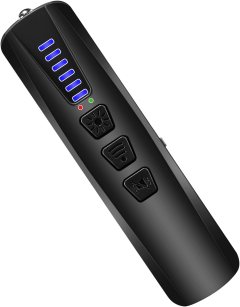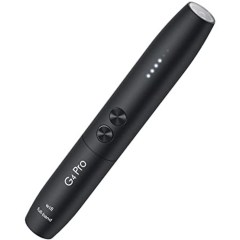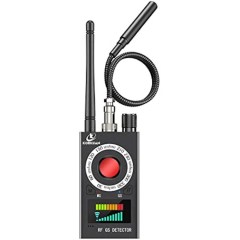BestReviews is reader-supported and may earn an affiliate commission. Details

This is a hidden camera detector with useful features for locating hidden cameras and other spying devices.
Versatile detector with 6 sensitivity levels and infrared radiation mode. Can detect cameras, magnetic fields, GPS, and audio bugs. Offers a night vision function for low-light situations. Its lightweight, compact construction makes it a great choice for traveling.
Beeping alerts can be difficult to understand and may go off inconsistently.

If value is important to you, chances are you'll be impressed with the features, accuracy, and price this detector device offers.
Multi-functional model that detects cameras, magnetic fields, radio frequency signals, GPS, and other bugs. The updated version has 4 modes to suit different needs. Compact design. Charges quickly and gets up to 30 days of use per each full charge.
Somewhat confusing to set up. Instructions could be clearer.

This detector is as convenient as it is effective thanks to its sensitivity settings and run time.
While barely larger than a pen, this device manages to detect all manner of spying devices. Has 25 hours of continuous use with a full charge, and only weighs 30 grams. Made with traveling in mind. Very sensitive making it effective for lots of different scenarios.
More effective at detecting cameras in dark environments than in bright rooms.

A very sensitive option, this detector effectively reads magnetic and sound waves to locate obscured signals from cameras and audio bugs.
Quickly becomes your best friend in terms of spying device detection. One of the more versatile products available that doesn't discriminate from detecting GPS data to mobile phone devices. An easy favorite for those in need of a product that acts fast.
May not work effectively in crowded environments where cross signals occur.

A wealth of features including being lightweight makes this device a terrific means to detect wireless spying devices.
Can detect WiFi and data-based spying devices, as well as wired equivalents. Can hold a charge for up to 10 hours while in use, or 7 days while in standby mode. The brand also offers a redacted help center. Great for those who are worried about cameras frequently.
Larger design and lower battery life make this unit less than ideal for use while traveling.

We recommend these products based on an intensive research process that's designed to cut through the noise and find the top products in this space. Guided by experts, we spend hours looking into the factors that matter, to bring you these selections.

They are on street corners and coffee shops. They watch you eat, ride the streets, and shop. Cameras are everywhere these days, and a quick search on Amazon shows that this trend has also spilled into the amateur world with a wide selection of tiny, inexpensive consumer cameras that are easy to hide. While people use these to keep an eye on their homes, pets, and children, those less scrupulous are using them to spy on the activities in changing rooms, hotel suites, and more.
Checking your surroundings for hidden cameras has become an unfortunate necessity, and one way to do this is with a hidden camera finder. These devices use a couple of different technologies to sweep for not only hidden cameras, but also audio bugs, GPS trackers, and more.

Hidden camera finders use one of two methods to sniff out hidden cameras: radio frequency (RF) detection or camera lens finders.
Hidden camera finders that use RF detection pick up on the radio waves used by wireless cameras to transmit information. These can detect signals anywhere from 1MHz to 10GHz or higher, depending on the finder. More professional finders are able to detect a greater and higher range.
In addition to cameras, RF detectors can be used to find a number of other types of devices such as audio bugs, GPS trackers, and even mobile phone SIM card bugs.
To use these, you typically turn on the device and start slowly walking, or sweeping, through the room. If the finder detects an RF signal, it alerts you. The majority of these ramp up the alert the closer you are to an object, making it easier to find.
A camera lens finder, by contrast, is used solely for the detection of hidden cameras. It relies on flashing LED or laser lights that bounce off camera lenses and give away their presence.
To use a camera lens finder, you activate the finder and hold it up near your eye (some include lenses that you actually peer through). Like RF detection, you then slowly sweep the room. A hidden camera shows up as a flash of light reflecting back at you.
Some hidden camera finders use RF detection, some a camera lens finder. The best incorporate both, providing you with more options for tracking down a hidden camera.
Hidden camera finders are largely hand-held devices that use some form of battery as a power source. Some use disposable batteries, such as a single 9V. More commonly they use a rechargeable battery. If a device uses a rechargeable, know how long a charge lasts and how the unit is charged. You should also verify that it ships with all the cords you need to recharge it.
The camera finder you choose should offer clear reporting so you can quickly tell when you’ve detected a device and can easily track it down. These typically have a simple design with minimal controls, so by and large they are not overly difficult to use. Further, a more compact model that can be used with one hand is not only easier to use, it’s also more discreet.
Learn if your hidden camera finder is able to weed out cross signals — wireless signals you can’t control — or if it constantly throws up false positives. The addition of a sensitivity control can help to overcome cross signal issues.
There are three types of alerts that you encounter with these devices: sound, light, and vibration. If you detect a signal, a device may use one or more of these to let you know. The best devices provide you with options on what you wish to use for alerts and provide features (an ear jack, vibrate only) so that you can use the unit discreetly.
The controls for these are fairly straightforward and are usually in the form of an on/off switch and some way to dial-in sensitivity. A way to determine signal strength — usually in the form of a series of LED lights — is also standard.
While not standard, the following advanced features can be found on some hidden camera finders.
The addition of a white noise generator can help to suppress listening devices.
Some finders include the ability to be “always on” and inform you of RF signals that are suddenly detected.
Some finders include two telephone ports, so you can use the unit with your landline to find out if your phone is being tapped.
Verify that a hidden camera finder ships with all instructions and charging cords necessary to understand and run it. Some include earphones so you can use the unit more discreetly.
As this is an emerging market, more finders now incorporate a range of other personal safety features, from alarms to flashlights. You can expect to find much more of this going forward.
Hidden camera finders start out around $30 and can run up to hundreds of dollars for more professional models. The two primary price ranges for the majority of these are $30 to $50 and $50 to $100.
Inexpensive: In the lower range, you tend to find simple camera lens finders or RF detectors, while some may incorporate both. These offer basic, no-frills detection, but are still effective.
Expensive: At higher price points, you are able to detect a wider frequency band and pick up on more devices. You can also find more advanced features and overall better build quality.

Q. Will a hidden camera finder work for both wireless and wired cameras?
A. It depends largely on what type of finder you choose. If you get one with a camera lens finder, it should be able to find both wired and wireless cameras. A hidden camera finder with only an RF signal detector, however, can only find wireless cameras and then only when the wireless cameras are on.
Q. Why does my finder keep beeping or otherwise returning false positive hits?
A. If the unit is saying that there is something there but there isn’t, the sensitivity may be turned up too high. Try adjusting the sensitivity. You may also be running into a variety of other signals which may be affecting the unit. Be sure that all wireless networks, routers, and WiFi devices are disconnected before using your hidden camera finder.
Q. In addition to a hidden camera finder, what can I do to locate hidden bugs and cameras?
A. When in a new environment such as a hotel room, take some time to really examine everything around you. Some areas to concentrate on include:
Get emails you’ll love.
Learn about the products you’re wondering if you should buy and get advice on using your latest purchases.
